
Lucy, Linus, Schroeder, Sally, and Snoopy celebrate the life of a boy named Charlie Brown in the crowd-pleasing musical You’re A Good Man, Charlie Brown, now being given a positively irresistible guest production at North Hollywood’s intimate Theatre Banshee.
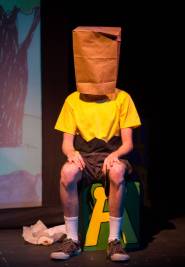
 Newspaper comics staple Charlie Brown had already been around for seventeen years and starred in a pair of animated TV specials when You’re A Good Man, Charlie Brown made its off-Broadway debut way back in 1967. West End and Broadway runs followed, along with countless regional, community, and school productions before Charlie & Friends returned to the Broadway stage in the 1999 Best Revival Tony winner, a big-stage revisal featuring a much-tweaked book and a few new songs (courtesy of its Broadway director Michael Mayer and Broadway songwriter Andrew Lippa).
Newspaper comics staple Charlie Brown had already been around for seventeen years and starred in a pair of animated TV specials when You’re A Good Man, Charlie Brown made its off-Broadway debut way back in 1967. West End and Broadway runs followed, along with countless regional, community, and school productions before Charlie & Friends returned to the Broadway stage in the 1999 Best Revival Tony winner, a big-stage revisal featuring a much-tweaked book and a few new songs (courtesy of its Broadway director Michael Mayer and Broadway songwriter Andrew Lippa).
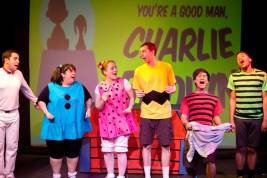 It is this considerably richer You’re A Good Man, Charlie Brown that now reunites the creative team behind last year’s multiple Scenie-winning Miss Saigon—director Neil Dale and choreographer Janet Renslow—and three of its stars (Eymard Cabling, James Oronoz, and Colette Peters) in radically different roles from the ones they played at Candlelight Dinner Theatre.
It is this considerably richer You’re A Good Man, Charlie Brown that now reunites the creative team behind last year’s multiple Scenie-winning Miss Saigon—director Neil Dale and choreographer Janet Renslow—and three of its stars (Eymard Cabling, James Oronoz, and Colette Peters) in radically different roles from the ones they played at Candlelight Dinner Theatre.
I must confess to having not been a big fan of You’re A Good Man, Charlie Brown the first time I saw it a dozen or so years ago, due as I recall to its lack of storyline and a cast that may have been a tad too old to play elementary school kids.
With the passage of time, I have come to love Charlie Brown’s book (by Clark Gesner with additional dialog by Mayer and based on Charles M. Schulz’s comic strip), and the 20something triple-threats who bring the Peanuts gang to life on the Theatre Banshee stage are precisely the right age to convince an audience that despite having twenty or so years on the roles they’re playing, they’re really 5-to-8-year-olds at heart.
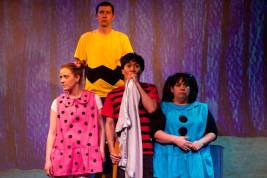 In retrospect, I wish I’d appreciated just how terrific Gesner and Mayer’s book is the first time round—essentially a series of sketches that do precisely what they’re supposed to do, i.e. replicate the 4-panel daily Peanuts strips and their 10-panel Sunday counterparts in short vignettes, each with its own punch line. Take for instance when Lucy attempts to strike up a conversation with her main crush Schroeder, who only has fingers for his piano, leaving Lucy to gripe, “My Aunt Marion was right. Never try to discuss marriage with a musician.”
In retrospect, I wish I’d appreciated just how terrific Gesner and Mayer’s book is the first time round—essentially a series of sketches that do precisely what they’re supposed to do, i.e. replicate the 4-panel daily Peanuts strips and their 10-panel Sunday counterparts in short vignettes, each with its own punch line. Take for instance when Lucy attempts to strike up a conversation with her main crush Schroeder, who only has fingers for his piano, leaving Lucy to gripe, “My Aunt Marion was right. Never try to discuss marriage with a musician.”
All the favorite Peanuts themes are there, with the conspicuous exception of the unfailingly hilarious football gag. There’s Charlie’s infatuation with the Little Red-Haired Girl, Linus’s inability to function without his blanket, Lucy’s side-job as a 5-¢-per-consultation shrink, and Snoopy’s fantasy life as The Red Baron, to name just a few.
Many of these situations find their expression in song (music and lyrics by Genser). There’s Linus’s “My Blanket And Me,” which has him attempting in vain to “walk away and leave it, though I know you won’t believe it. I’ll just walk away and leave it on the floor.” (As if.) “The Doctor Is In” has Lucy forcing Charlie Brown to list his many failings, to which she responds with, “You don’t think that mentioning these few superficial failings is going to do you any good, do you? Why, Charlie Brown, you really have to delve.” Know-it-all Lucy later teaches Charlie some “Little Known Facts,” like: “You see that bird? It’s called an eagle. But since it’s little it has another name, a sparrow, and on Christmas and Thanksgiving we eat them.” And let’s not forget Charlie Brown’s signature song, the now classic “Happiness.”
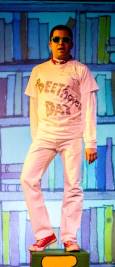
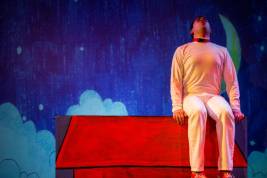 Lippa’s contributions are some of the show’s best. The R&B “Beethoven Day” has Schroeder attempting to convince his pals to fete his all-time favorite composer with a holiday dedicated to “the man we adore on the day we place the newest face on Mount Rushmore!” Even better is Sally’s “My New Philosophy,” of which she has several, including, “Oh, yeah. That’s what you think?” and “Why are you telling me?” and “No!” and “I can’t stand it!”
Lippa’s contributions are some of the show’s best. The R&B “Beethoven Day” has Schroeder attempting to convince his pals to fete his all-time favorite composer with a holiday dedicated to “the man we adore on the day we place the newest face on Mount Rushmore!” Even better is Sally’s “My New Philosophy,” of which she has several, including, “Oh, yeah. That’s what you think?” and “Why are you telling me?” and “No!” and “I can’t stand it!”
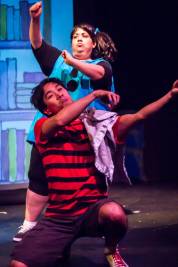
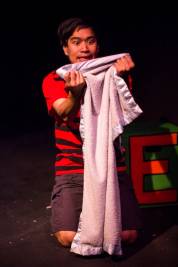 All of this comes together on the Theatre Banshee stage under Dale’s inspired direction, with Renslow creating one sparklingly inventive dance sequence after another. (The Blanket Ballet is a favorite of mine.)
All of this comes together on the Theatre Banshee stage under Dale’s inspired direction, with Renslow creating one sparklingly inventive dance sequence after another. (The Blanket Ballet is a favorite of mine.)
As for the show’s Grade-A cast, the real Charlie Brown may not have towered over his pals the way Chris Duir does, but the tall, gangly look does quite the trick in making Charlie the perennial outsider, and Duir’s performance is a charmer and his vocals terrific as well.
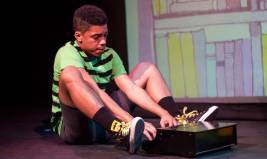 The reunited Miss Saigon stars are each and every one unrecognizable from their Candlelight roles, each one more splendiferous than the other. Cabling is a combination of endearing and adorable as just about the cutest and most winning a lisping, thumb-sucking Linus as you could wish for. Oronoz nails Schoeder’s head-in-the-musical-clouds attitude and bearing, and his delightfully dry facial reactions are well worth paying special attention to. Peters may well be the best in the cast at channeling her inner child, and her scene-stealing Sally is at her scene-stealingest best in the show-stopping “My New Philosophy.” All three are splendid vocally, by the way.
The reunited Miss Saigon stars are each and every one unrecognizable from their Candlelight roles, each one more splendiferous than the other. Cabling is a combination of endearing and adorable as just about the cutest and most winning a lisping, thumb-sucking Linus as you could wish for. Oronoz nails Schoeder’s head-in-the-musical-clouds attitude and bearing, and his delightfully dry facial reactions are well worth paying special attention to. Peters may well be the best in the cast at channeling her inner child, and her scene-stealing Sally is at her scene-stealingest best in the show-stopping “My New Philosophy.” All three are splendid vocally, by the way.
Carla Jimenez couldn’t be funnier (or sing more sensationally) as Lucy, giving the Original Mean Girl a soft side that makes us love her even as we cringe at just how awful she is to Charlie.
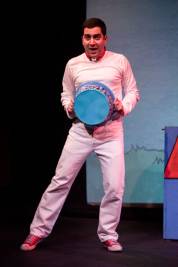
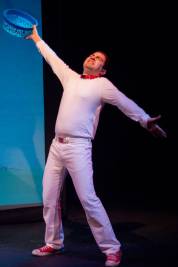 Finally, there is Theatre Out favorite Frankie Marrone in full-beagle mode, doing considerable scene larceny as the world’s favorite pup, whether in “Curse you, Red Baron!” mode or extolling the virtues of “Suppertime” (“Bring on the soup dish, bring on the cup. Bring on the bacon and fill me up! Cause it’s supper, supper, supper, suppertime!”) in his own show-stopper of a number, one which choreographer Renslow gives a Michael Bennett-meets-Bob Fosse pizzazz.
Finally, there is Theatre Out favorite Frankie Marrone in full-beagle mode, doing considerable scene larceny as the world’s favorite pup, whether in “Curse you, Red Baron!” mode or extolling the virtues of “Suppertime” (“Bring on the soup dish, bring on the cup. Bring on the bacon and fill me up! Cause it’s supper, supper, supper, suppertime!”) in his own show-stopper of a number, one which choreographer Renslow gives a Michael Bennett-meets-Bob Fosse pizzazz.
Kudos go out to musical director Marc Macalintal, who has the cast harmonizing to perfection to prerecorded tracks. Director Dale gets top marks for his side jobs as lighting designer, technical director, and computer graphics designer, assisted in the latter by Adam Trent (who also understudies Charlie Brown at selected performances.) Dale’s scenic design consists of a few colorful comic-strip-type set pieces placed in front of a big screen onto which comic-strip backgrounds get projected, a nifty design choice for a production in an intimate space and on a budget. Dale’s savviest decision was to project those graphics from behind, meaning that backdrops are never drowned out by lighting or hidden by performer’s shadows. A deliberate, hilarious exception is Charlie’s head-to-tree banging, and there’s a quite magical kite-flying sequence that combines an honest-to-goodness flying kite (thanks to an almost invisible thread) in front of wispy, animated clouds. Eva Capa is credited for the cast’s just-right costumes.
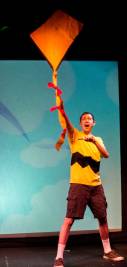
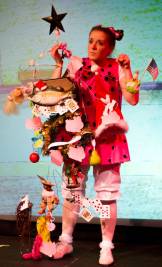 Behind the scenes crew includes Mary Ann Belinget, Bob Farina, Gina Farina, Logan Grosjean, Daniel Moorefield, Ampi Naranjo, Janis Peters, Lily Vilar, Raun Yanovich, and most importantly stage manager Therese Peters. John Peters is executive producers for J & J Productions, in association with Theatre Banshee. Jennifer Strattan plays Lucy at selected performances.
Behind the scenes crew includes Mary Ann Belinget, Bob Farina, Gina Farina, Logan Grosjean, Daniel Moorefield, Ampi Naranjo, Janis Peters, Lily Vilar, Raun Yanovich, and most importantly stage manager Therese Peters. John Peters is executive producers for J & J Productions, in association with Theatre Banshee. Jennifer Strattan plays Lucy at selected performances.
You’re A Good Man, Charlie Brown is that rare production that audiences of truly any age can enjoy, from tiny tots (whose delighted giggles made for an even more delightful Opening Night) to their grandparents, who grew up reading the same Peanuts comic strips and seeing the same Peanuts TV specials as their grandchildren do today. To put it simply, I had a Charlie Brown ball from start to finish and so will you.
Theatre Banshee, 3434 W. Magnolia Blvd., Burbank.
www.brownpapertickets.com/event/295444
–Steven Stanley
January 18, 2013
Photos: Adam Trent


 Since 2007, Steven Stanley's StageSceneLA.com has spotlighted the best in Southern California theater via reviews, interviews, and its annual StageSceneLA Scenies.
Since 2007, Steven Stanley's StageSceneLA.com has spotlighted the best in Southern California theater via reviews, interviews, and its annual StageSceneLA Scenies.







 COPYRIGHT 2025 STEVEN STANLEY :: DESIGN BY
COPYRIGHT 2025 STEVEN STANLEY :: DESIGN BY